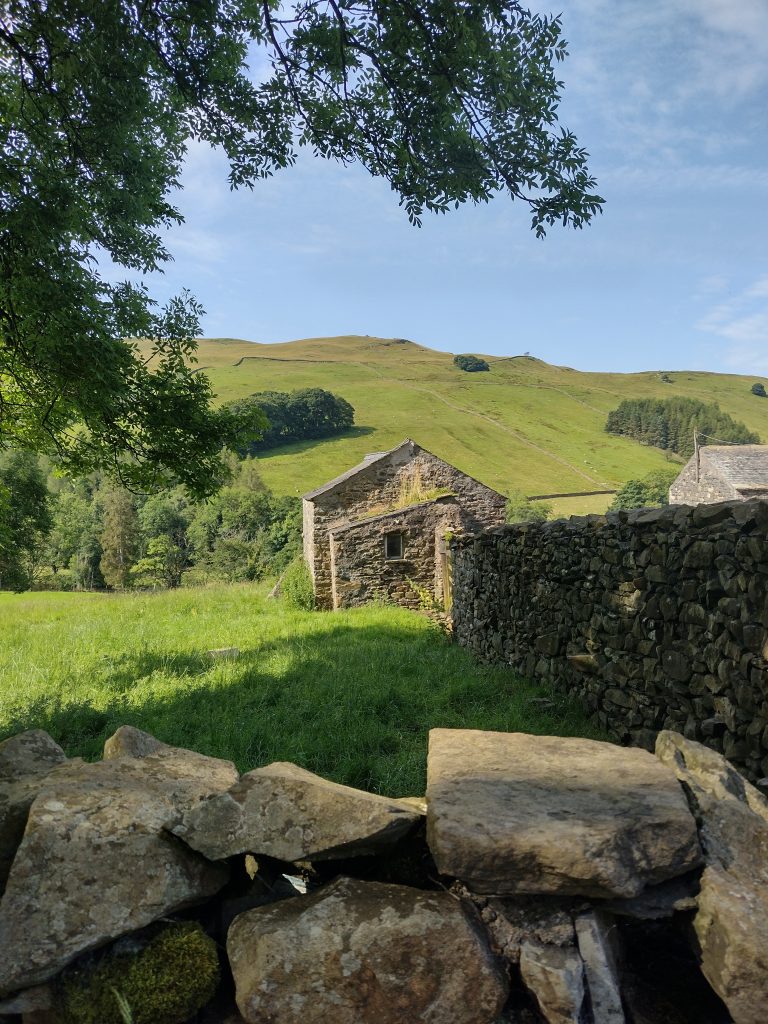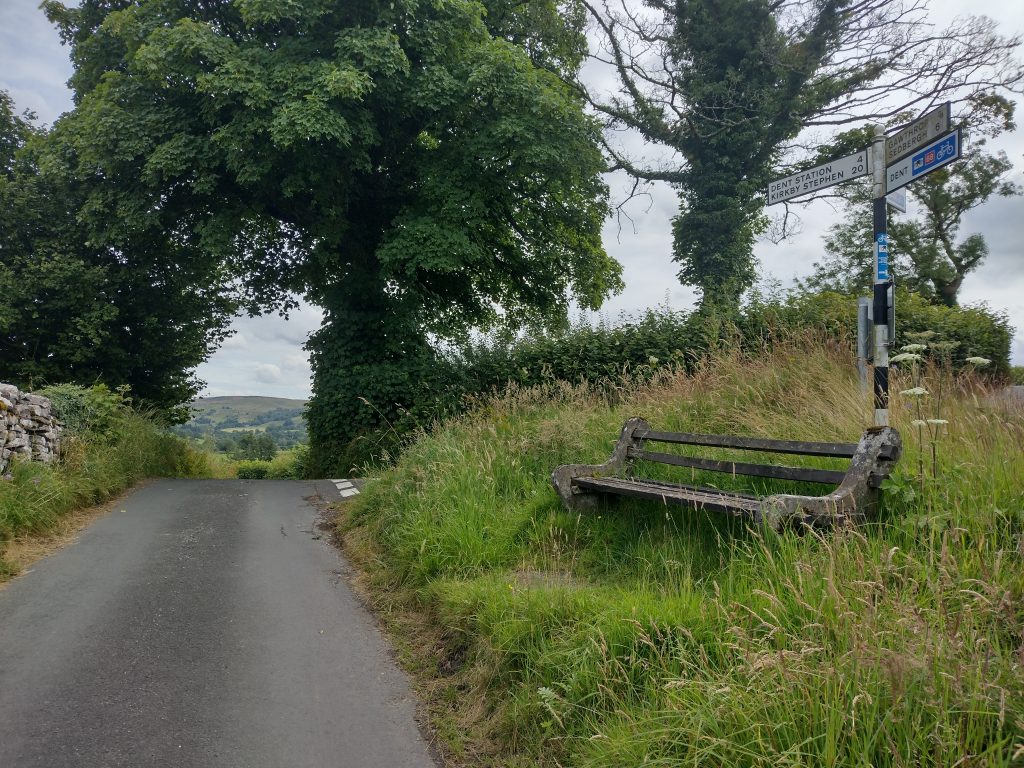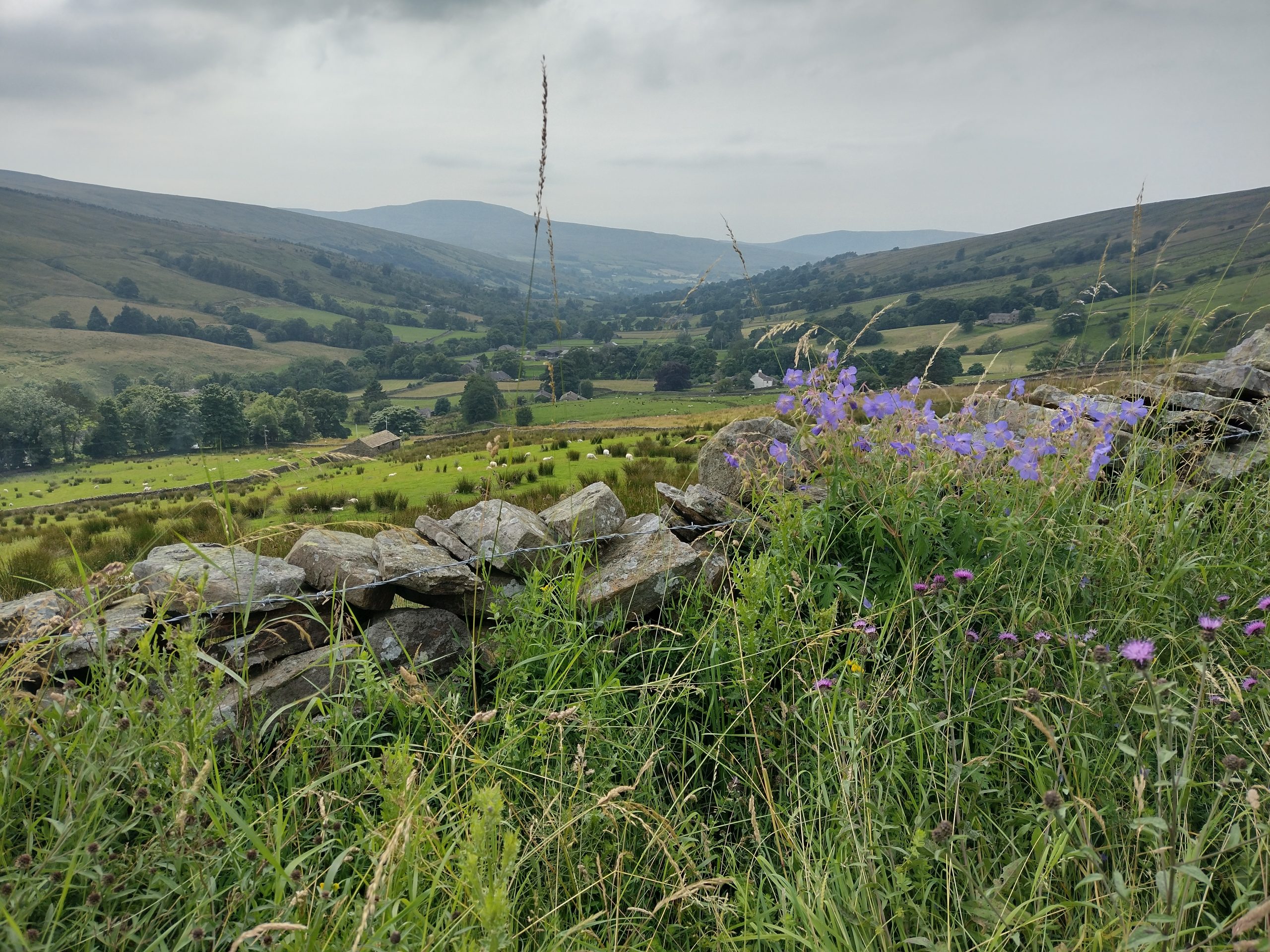Day 3: Wednesday, July 24th 2024
Finding affordable single accommodation along the Dales Way was a significant challenge, and one I had to rise to well in advance. Gone are the days, sadly, when one could study the weather, pack a bag and hasten out the door at the last minute, stopping when tired and finding a bed by way of a ‘Vacancies’ sign outside a conveniently placed private house. Nowadays, not only are most rooms booked up weeks or months ahead, but the prices are eye-watering, especially when you are bearing the cost alone. With very few true single rooms available and little, if any, discount given for one person using a double, I had to accept that this trip would cost around the same amount as a week in the Caribbean. The other alternative was to carry tent, sleeping bag, food and stove on my back. I wouldn’t have even made it up the hill from Bowness.
In Sedbergh I found a room in someone’s home, and as he was away, I had the run of the place. Not that I was doing much running; crawling up the stairs and into the shower was about all I could manage, but I enjoyed sitting cross-legged on the landing and leafing through a pile of maps and guidebooks to exotic places: the homeowner was a fellow traveller, with artefacts adorning walls and shelves. I would have liked to have met him. Having the large, stone-flagged kitchen to myself was, however, a revelation. The joy of filling my flask with real, ground coffee made in a cafetière, and with warmed soya milk kindly left out for me, cannot be overstated. Sandwiches made from real bread; fillings prepared with a sharp knife on a wooden chopping board…the little things you don’t miss until they aren’t available.
Well rested, and surprisingly ache-free, I skipped out into the morning sun. Locking the door behind me I placed the key back into the wall-mounted safety box, which immediately fell off in my hand. Whistling nonchalantly, I gently replaced it as best I could, and left the scene. This sleepy town-village didn’t strike me as a hotbed of crime. And I wasn’t guilty.
The centre of Sedbergh sits on a hill, so it was down all the way to Millthrop, which is a pleasant way to start, if you’re able to ignore the fact that what goes down must, eventually, come back up. Millthrop was manicured, florally decorated and appealing in a biscuit-tin kind of way; so much so that I walked through it several times. On reaching the hamlet (or the crossroads which passes for a hamlet), I was confronted by a sign, Dales Way, pointing in both directions. Now, I realised that my gut had thus far been unreliable, to say the least. But with my fresh, morning alertness, I knew that I should be heading east, and as I was now south of where I started, that surely indicated I should turn left. As I had not entered Sedbergh via the Dales Way the previous evening, I assumed the right-pointing sign was where I would have emerged, had I not availed of the lift. With a cheery wave to the binmen whose yellow lorry was all but blocking the narrow lane, I was on my way.

With rampant hedgerows and soft green, hilly views, the going was easy; today would be a good day. Until I hit the A684, which didn’t look right at all, with a destination choice of either Hawes, or back to Sedbergh. Not Dent, then. I scratched my head. How could the road to Dent be heading west, unless it curved round in a big loop, invisible from where I’d been standing? (Answer: it does). In any case, there was no footpath here. Back I shuffled along the lane, still optimistic, admiring the colourful hanging baskets, waving again at the bin men, who hadn’t progressed very far; tortoises to my skittering, zig-zagging hare.
Retracing my steps, I tried turning the other way, the counter-intuitive way. A wide track seemed to lead into a field, then peter out. I’d been had that way before; I followed the road, past Sedbergh golf course, going what I knew was in the wrong direction, yet there were signs to Dent. At the very worst, I’d reach the first settlement by road, and a very lovely one it was, too, dappled by oaks and lined with drystone walls; vibrant green fields scattered with barns in various stages of tumbledown.

The road curved up and up, high above the River Dee, itself a thin sliver of indigo weaving through the woods. After a mile or so there was a stile over the wall on my left, with a clear path up and over the steep, grassy crest, evidently leading back to Millthrop. I supposed it could have been the disappearing track I’d pooh-poohed; if so, I could have cut a rather large corner. The road ahead, delightful as it was, seemed to stretch on without end, and I badly needed the loo. Flanked by the usual hedgerow vegetation – including nettles – with cars periodically speeding past and the walls, in the absence of further stiles, too high to scale, there was nowhere obvious to remedy this, so I walked cross-legged. I was high above the river by now, yet certain I should be walking beside it. How I was supposed to get down there was anyone’s guess. A sense of déjà vu was creeping in.
In the widened entrance to a grand mansion, I stood and watched a handful of vehicles pass before tentatively sticking my thumb out. This walk was supposed to be enjoyable; it was clear, by now, that I would not find a way off this little road before I reached Dent, and I couldn’t concentrate on maps or instructions with a full bladder, so it was with some relief I got into the passenger seat of a lovely lady from Essex, visiting her daughter. Within ten minutes I was deposited outside the public toilets, before beginning the process all over again by drinking my coffee on a sunny bench. There was a tempting-looking café across the street in this gorgeous, photogenic village; the one day I found such a thing at the appropriate time was the day I already had the perfect liquid in my flask. They weren’t scarce of customers, mind you, and this sweet little village was buzzing, despite the difficulty I seemed to have had in reaching it.

It was ideal weather for map-reading; unfortunately, the route was falling off the edge of the Belgians’ kind gift. To my surprise, I was able to open Google maps on my phone with a small degree of success, now I was in the centre of a Dales-style urban metropolis, although as I suspected, the signal was soon lost. I took advantage of what little I could receive and had a good look at the route ahead. It seemed simple enough: I needed to head to the river, and follow it. There were one or two places where I should cross the road and continue on the other side, but mostly it looked straightforward. The river was directly in front of my bench; the way itself distinct, dry, flat and even. I went through a succession of gates and relaxed into a steady, purposeful rhythm.
I was on my way to the Station Inn at Ribblehead; I’d heard good things about the place, and was really looking forward to my stay. Tomorrow, I’d reach the highest point of the entire walk before entering more familiar terrain; this was my last afternoon of unchartered territory and it was getting prettier by the hour. I would savour these precious moments and enjoy a stressless afternoon.
I went through a gate into a cows’ field. The path went straight across, and then stopped abruptly. I returned to the gate: yup, this was definitely the Dales Way. It even said so on the (reverse of) the gate. Once again, I crossed the field. No visible means of escape. I tried diagonally; I faint sheep-track skirted a ditch and headed back up to the road. Was this where I should cross? No sign on the gate – either side. Back around, begin again. Where was the sign pointing? Follow it. Run out of path, look around for clues. Find none. Scream in frustration. Stamp feet. Does this wretched way even exist?
There was nothing for it but to climb back onto the road; at least I was certain it was heading in the right direction. And according to my virtually redundant Google maps, there should be a turnoff somewhere on the right. But that would take me right up the hill, and that couldn’t be right. Could it? I was safer with a road. It should only be a couple of miles, after all.

The lane had narrowed further, and I frequently had to step to the side for cars. Sometimes it was a direct choice between getting scraped by a vehicle or something far worse, falling into nettles. I walked, and I walked. My feet were sore from the relentless tarmac; my backpack sat heavy on my hips. I found a bench for a brief respite and my subconscious registered the signpost: Dent station, 4 miles. I had only walked a mile or so out of Dent, then, although I could scarcely remember coffee time, now. How long must I have spent circumnavigating the cows’ field? It was now lunchtime; I followed my picnic with a paracetamol before trudging on.

The river, during the brief interludes I managed to find the path beside it, was spectacular in its own quiet way: gouged-out circular hollows formed mini rockpools from the splashes and, presumably, the rain, although not today. Fissures in the smooth, weathered limestone had created miniature canyons, bright with moss and it took all my willpower not to dawdle even longer taking photographs from every angle. It’s a good job I’d decided against bringing my sketchbook, or I’d never have got anywhere. These little moments of wonder, experienced daily, helped pure joy to triumph over the pain and frustration I felt justified in moaning about. Perhaps the strength of one magnified the other in a ying/yang balance.
Surrounded by all this beauty, grateful I wasn’t getting a soaking, or blisters, but worn down by the weight of my uncomfortable pack; with sore, hot feet and exhaustion from the continual puzzlement of why I could never find the correct path (or even direction, in some cases), I stepped off the road into a driveway and lent against the wall, letting it take the weight off my back while I drank some water. It was warm. In the Highlands I would have replenished frequently under tumbling waterfalls but here there were too many farm creatures and I wasn’t sure about chemicals. My mother always lived by the rule that fast flowing is safe and stagnant is not. But she was brought up before the age of pesticide run-off and was really referring to the high fells, not a sluggish river on the outskirts of a village. So tepid tap water it was, for now.
Perhaps I stood out because I was so far off the track, or maybe I wore only negative emotions on my face, but a tractor crawling by pulled up in the middle of the lane and its driver looked down at me.
‘Are you lost, or just resting?’ he enquired.
‘Both.’ It was true. I wasn’t anguished, though; I was relatively content here in the sunshine.
‘Where are you trying to get to?’ he looked amused.
He told me that Lea Yeat, the next point on the official Way, was still a mile or two further on. The footpath was ‘up there’ – he pointed at the hill – or I could just walk along the road. There wasn’t much difference. I asked him if he was going that way? He chuckled, but didn’t confirm. Once the words were out, though, I realised there was no better solution, and this tractor was not getting away without me in it. Or on it, to be more precise. There was only one seat, the driver pointed out. No room in the cab! My ears went down.
‘Unless…’ he offered.
The wheels were nearly as tall as I was. Removing my offending pack and passing it to the driver, who placed it between his knees, I clambered up onto a narrow metal platform and held onto the open doorway of the cabin, facing in.
‘You’d better cling on tight,’ the driver said. ‘It’s a long way down!’
He wasn’t kidding. But I had no intention of ending up down there, accidentally or otherwise, until I had gone as far along this merciless road as he was willing to take me.
His farm was in Cowgill, which seemed to be part of the same settlement, consisting of fields, farms and about three houses. It also had a stone packhorse bridge across the river, which I made for once I had been gracefully deposited, reunited with my bag and thanked the kind driver. We’d enjoyed a fine chat during the fifteen minutes or so we chugchugchugged along; he purposefully oblivious to the motorbike behind us, and I now viewing a familiar situation from an unfamiliar angle.
‘You’re doing it t’wrong way round,’ he ventured.
I hadn’t been aware there was a ‘right’ or a ‘wrong’ way of doing it; just a ‘usual’ and ‘slightly less usual’ way. But I’m all for learning.
‘All the signposts will be pointing t’other way,’ he added. Well, yes. Where they exist at all.
‘That’ll be why you’re lost.’ I couldn’t disagree on that. There were other topics of conversation I avoided, of course.
Under the bridge the river formed blissfully clear, deep pools between the flat rocks, and for an indecently long time I trailed my legs in the water with a contentedly empty mind. Sadly, it couldn’t last forever. Voices from above startled me back to reality and I looked up to see two women leaning over the bridge, gazing longingly at my decadence. They told me they’d walked all the way from Oughtershaw; it wasn’t all that far, they said to my astonishment; but the last three miles had been a killer, all along the road. The next four didn’t seem to daunt them; I supposed they’d be following a proper footpath, not clinging onto the outside of a farm vehicle.
I began to question my fitness, or was it my dedication and determination which was lacking? I was now facing three tedious miles of tarmac, followed by another one and a half to reach the Station Inn, as it doesn’t sit perfectly on the route; it’s just the only hospitality for miles around. Drying my feet on my socks before putting them back on, I stood up with a renewed resolve, and headed straight up the near-vertical three quarters of a mile to Dent railway station. As the highest station in mainland Britain, it seemed a shame to miss it.
The historic station, with its red-painted doors and benches, was deserted. I ascertained there
was a train in around half an hour, so I lay down and closed my eyes just as it started to drizzle. When the train came it was stuffed full of walkers and school children, the driver in full spiel on his intercom as he gave us a potted history of the Ribblehead viaduct. It took five years to build it, that’s all I can remember, but he made it all very entertaining. I had no cash on me, and there was no Wi-Fi available to use my card; fortunately, the conductor was also in cheerful humour and, as I had only hopped on for one stop, he shrugged and moved along. I felt as if I’d accidentally caught a party train; for once, I reckoned I’d made a good decision.
Although the Station Inn is slightly off-piste as far as the Dales Way is concerned, it is reachable by road, and sits directly opposite the station, hence its name. Inside it was bustling and it was quite surreal to be queueing for a table in the bar after the solitary trails (particularly the ones I invented myself) but I thoroughly enjoyed a tasty, if pricey, vegan ‘burger’ before retiring to my cosy room for the sleep of the virtuous. Tomorrow, I vowed, I would do better.

Extra miles: 3-3½
Miles skipped: 4-5
Official time: 7 hours
Time spent being lost: 1 hour
Time saved by cheating: 3 hours
Total time taken: 8 hours
Difficulty rating: A lot of road walking, much of it unintentional, and a steep (unscheduled) climb up to Dent station; otherwise, easy. The lack of waymarking was off the scale today, though, and I reached peak frustration.
